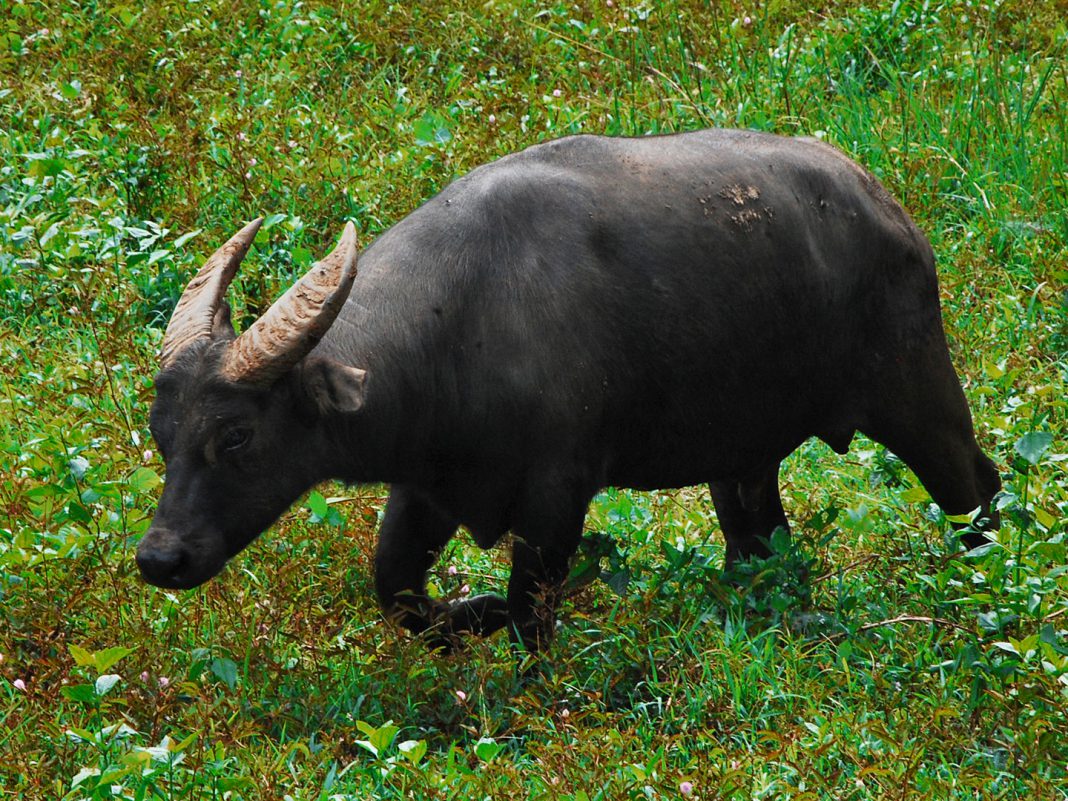The truth about a secret black beauty in Mindoro
Dr. Rebekka Volmer
The tamaraw is the national land animal of the Philippines. But only who is willing to go through a 6-hour pilgrimage through challenging, steep terrain, crossing slopes and rivers to Mount Iglit, at Baco, Oriental Mindoro will be able to see it. The place where the last remaining herds of tamaraw roam in secret.
The tamaraw is often underestimated as being simply as a small form of a carabao, just with V-shaped horns instead of u-shape horns typical for carabaos. Personally, I also met Kali, the only captive tamaraw living in the gene pool (TCP), and I was amazed by his black fur, and his gracile statue. But in fact, he looked like a small carabao.
Carabaos are domesticated animals and can be seen almost everywhere outside the city. They are introduced into the Philippine Islands and other water buffaloes breeds from China and Cambodia are also interbred. The carabao as an animal is significant in agriculture. During World War II, the Japanese even killed about 70% of the carabaos and caused severe hunger among the farmers who desperately needed the animals to farm their fields. The carabao is deeply serrated in Philippine culture, and it becomes obvious why it is often seen as the national animal – it is symbolizing hard work and industriousness. The carabao’s bull-like appearance and the impressive horns give it the charisma of energy and power. However, this power is used for someone else – the farmer. Although strong, the carabao is at the same time docile and subservient.
The tamaraw appears less impressive and more gracile. But is it less powerful? The tamaraw is ferocious with a keen sense of smell. It can detect its attacker even a mile away. It is a wild animal – and shouldn’t be a wild animal more representative as a national animal?
“The tamaraw can be likened to us Filipinos, who can easily shift from one terrain to another, resilient and enduring. I believe that this animal can best represent our country,” Leachon said, and under House Bill 4606, the tamaraw was officially adopted as the national land animal. November 15 as the National Tamaraw Commemoration and Awareness Day, coinciding with the foundation days of Oriental and Occidental Mindoro.
However, the tamaraw is listed as critically endangered by the IUCN SSC Asian Wild Cattle Specialist Group, headed by Dr James Burton. Habitat destruction and illegal hunting are the biggest threats to the tamaraw.
Dr Ma. Josefina P. Abilay, Regional director of the DOST-MIMAROPA was calling for a round table discussion on tamaraw conservation in January 2019. The population is monitored by counting in the frame of a collaborative initiative headed by Ms June Pineda Programme Manager of the Tamaraw Conservation Programme together with the Far Eastern University. Further, cameras are installed to detect the presence of tamaraw and movements according to Mr. Luis Caraan, the project manager of Western Mindoro Integrated Conservation Program from the WWF Philippines. Thus, it is further threatened by inbreeding – lethal genes can accumulate having the same severe consequences as we know it from marriages between cousins.
Captive breeding of tamaraw was first started with the Tamaraw Gene Pool Farm (GPF) in Manoot, Rizal. The facility was established in 1980 for ex-situ (off-site) breeding of the tamaraw. This was a big step towards conserving the tamaraw. However, only one tamaraw – Kalibasib, meaning Kalikasan Bagong Sibol (nature newly sprung) was born in 1999. Dr Lerma Ocampo from the Philippine Carabao Center proposed to freeze and store sperms for artificial insemination for potential tamaraw reproduction in the future. Thus, the Far Eastern University established a conservation programme – Tams-2: The Tamaraw Times Two project is ambitiously working on doubling the population of tamaraw by 2020.
The same significance has respect to the Mangyans. The last remaining tamaraws occur in the Mangyan ancestral domains where the Taw’buid tribes live. Dr Emanuel Schütz, a keen pioneer in tamaraw conservation who dedicated his research and life to the protection of this animal, thus established the Mangyan-Tamaraw Driven Landscape Program. The inclusion of the Manyang in every step and action of conservation is the strategy of the programme funded by the D’ABOVILLE Foundation.
Although the carabao and tamaraw are both representing values of Philippine culture, the truth is that a lot more energy, work, and passion is invested in the protection of the tamaraw. The tamaraw is wild and graceful and that makes it rare and beautiful. It gives him the power of the people – the people who dedicate their lives to protect this creature symbolizing the wild side of the Philippines – which gives our country uniqueness, astonishing beauty and the power of the people.
A brief documentary about the tamaraw video courtesy of ABS-CBN MatangLawin:














